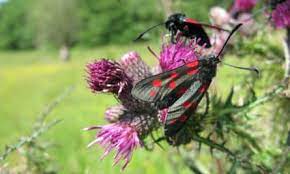UK horticulturalists call for more moth-friendly gardens

London: Gardens should be as attractive to pollinators at night as they are in the day, horticulturalists have said, as they present a moth-friendly version at a flower show in Cheshire.
The RHS nocturnal pollinators experience garden at Tatton Park flower show, which began on Wednesday, showcases flowering plants that produce heady scents at night to attract moths, which a 2020 study found were crucial but “invisible” pollinators.
Many gardeners are optimising their backyards for bees and butterflies, which is also very important, but many do not think about how attractive their gardens are to nocturnal visitors.
The garden designer Sharon Hockenhull has filled her Tatton Park entrywith night-scented flowers. She said: “I’ve planted a lot of jasmine. That’s very, very heady. We’ve also got things like evening primrose, and scented stocks because that just smells so heavenly.”
The garden showcases flowering plants that produce heady scents.
The garden showcases flowering plants that produce heady scents. Photograph: Neil Hepworth/RHS
Hockenhull added: “All those beautiful evening scents, which we should all have in our garden space because we can get so much enjoyment out of it – and so can the moths. I’ve also designed it with a lot of white flowers for that sort of night-time luminosity.”
As well as beautiful late summer blooms, the garden features brambles, nettles and other plants commonly classed as weeds, because these are what moths like to lay their eggs on, and also provide food for caterpillars.
Hockenhall said: “They tend to breed in our native plants, and they are more specific as to where they breed than other insects. It’s so important to try to embrace the idea of wild plants in your garden. Bramble is amazing, some caterpillars love nettles, we in the gardening world need to encourage the idea of being more tolerant of these weeds.”
She added that gardeners needed to be more accepting of caterpillars that may munch on their plants. “We need to encourage people to be more tolerant of a few holes here and there in the leaves of their garden plants,” Hockenhull said. “After all, it means a caterpillar has visited and that your garden is doing its job for pollinators.”
As with all wildlife gardening, a diversity of habitats to appeal to different species is important, and Hockenhall has created a few of these as inspiration for visitors.
She said: “There’s lots of different habitats from trees to hedges to small shrubs. I’ve got a little rockery area because there are some amazing plants for native moths, like heathers and grasses and mosses. We’ve got a lovely perennial border that is full of vibrant colour and is full of nectar. We’ve also got a moisture-retaining area for the garden, to provide a water source for wildlife.”
Sharon Hockenhull and Georgia Tucker’s RHS nocturnal pollinators experience at the RHS Tatton Park flower show. Photograph: Tim Sandall/RHS
Dr Hayley Jones, an entomologist at the RHS, advises members on how to optimise their gardens for insects. She said the main advice she gave people was to focus on not making their gardens too tidy. “Provide spaces for hiding during the winter. So lots of moths make their pupa just under the top level of the soil or underneath leaf litter in a little crevice. The pupa are normally just very shallowly buried, so you’ve got to have some hiding places for that,” she said.
As well as night-flowering plants such as evening primrose and nicotiana for adult moths, Jones said providing food for caterpillars was important: “You’ve really got to support the caterpillar to really boost their populations.”





